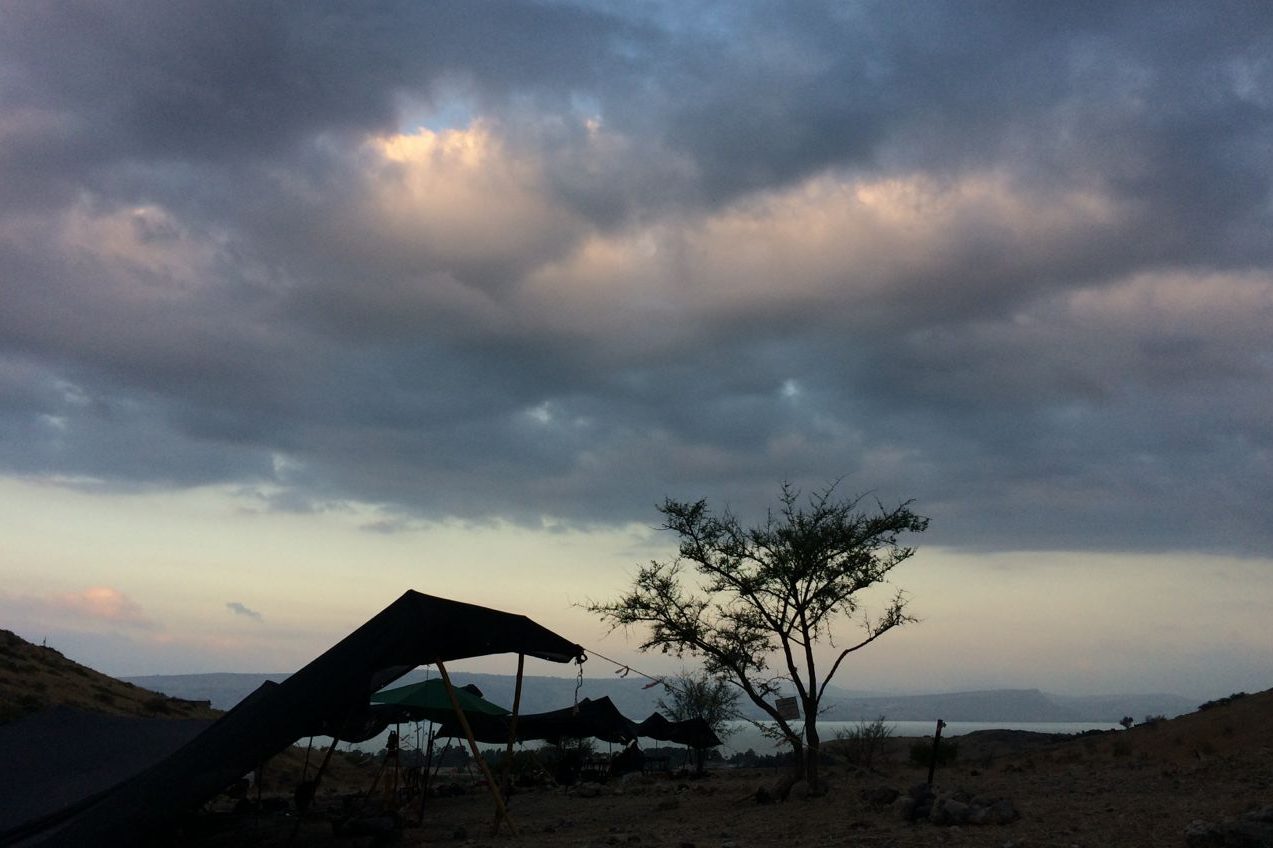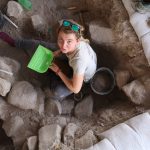
UConn graduate student Roxanne Lebenzon excavating at Nahal Ein Gev II, a 12,000 year-old archaeological site in northern Israel, east of the Sea of Galilee. (Photo by Laura Dubreuil)
Roxanne Excavating2
UConn graduate student Roxanne Lebenzon excavating at Nahal Ein Gev II, a 12,000 year-old archaeological site in northern Israel, east of the Sea of Galilee. (Photo by Laura Dubreuil)
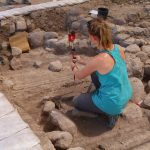
UConn graduate student Roxanne Lebenzon uses a line level to take detailed measurements at the dig site. (Photo by Laura Dubreuil)
Roxanne Excavating1
UConn graduate student Roxanne Lebenzon uses a line level to take detailed measurements at the dig site. (Photo by Laura Dubreuil)
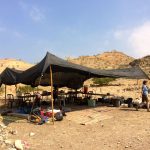
The Nahal Ein Gev II field lab for the researchers, an international team comprising a core of Israeli students and specialists, and student volunteers from the U.S., Australia, England, France, Spain, Greece, and Italy. The excavation is directed by Leore Grosman of the Hebrew University of Jerusalem. UConn anthropology professor Natalie Munro is the archaeozoologist. (Natalie Munro/UConn Photo)
The field lab. (Natalie Munro/UConn Photo)
The Nahal Ein Gev II field lab for the researchers, an international team comprising a core of Israeli students and specialists, and student volunteers from the U.S., Australia, England, France, Spain, Greece, and Italy. The excavation is directed by Leore Grosman of the Hebrew University of Jerusalem. UConn anthropology professor Natalie Munro is the archaeozoologist. (Natalie Munro/UConn Photo)
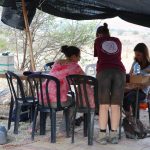
UConn professor Natalie Munro, right, works in the field lab at Nahal Ein Gev II, together with two Israeli students. (Photo by Laura Dubreuil)
Munro in FieldLab2
UConn professor Natalie Munro, right, works in the field lab at Nahal Ein Gev II, together with two Israeli students. (Photo by Laura Dubreuil)
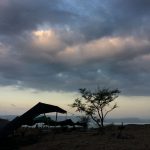
The site, located about two kilometers above the eastern shore of the Sea of Galilee in Israel, dates to the very end of the Epipaleolithic (Natufian) period (circa 12,000 calibrated years before present). This time is of special interest because it immediately precedes the first agricultural Neolithic communities, and thus presents many clues about why people abandoned their hunter-gatherer lifestyle for agriculture in the first place. (Natalie Munro/UConn Photo)
Site at Dawn (Natalie Munro/UConn Photo)
The site, located about two kilometers above the eastern shore of the Sea of Galilee in Israel, dates to the very end of the Epipaleolithic (Natufian) period (circa 12,000 calibrated years before present). This time is of special interest because it immediately precedes the first agricultural Neolithic communities, and thus presents many clues about why people abandoned their hunter-gatherer lifestyle for agriculture in the first place. (Natalie Munro/UConn Photo)
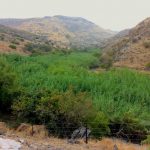
Despite the fact that the residents of Nahal Ein Gev II had not yet domesticated plants and animals, many aspects of their lives were Neolithic in character. They intensively exploited wild cereals (e.g., barley) and pulses (chick peas, lentils), and they had settled into the first more or less permanent communities. (Natalie Munro/UConn Photo)
Research in Israel. (Natalie Munro/UConn Photo)
Despite the fact that the residents of Nahal Ein Gev II had not yet domesticated plants and animals, many aspects of their lives were Neolithic in character. They intensively exploited wild cereals (e.g., barley) and pulses (chick peas, lentils), and they had settled into the first more or less permanent communities. (Natalie Munro/UConn Photo)
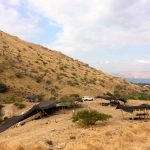
The site is of interest for its early architecture – the stone foundations of large structures and a cemetery with a number of human burials. Very early pure plaster was used to cover some of the graves. (Natalie Munro/UConn Photo)
View of Nahal Ein Gev II. (Natalie Munro/UConn Photo)
The site is of interest for its early architecture – the stone foundations of large structures and a cemetery with a number of human burials. Very early pure plaster was used to cover some of the graves. (Natalie Munro/UConn Photo)
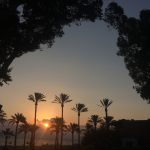
While excavating, the research team stays at Kibbutz Ein Gev, which is located on the shores of the Sea of Galilee. To beat the August heat, they must get up before dawn and leave for the site at 5 a.m. – arriving just before it begins to get light. They work until 1 p.m., and then take a siesta at the kibbutz – many of the team members swim in the lake. At 5 p.m., the researchers reconvene to wash and sort artifacts on the big lawn by the lake. (Natalie Munro/UConn Photo)
View of Sea of Galilee from Kibbutz Ein Geve (Natalie Munro/UConn Photo)
While excavating, the research team stays at Kibbutz Ein Gev, which is located on the shores of the Sea of Galilee. To beat the August heat, they must get up before dawn and leave for the site at 5 a.m. – arriving just before it begins to get light. They work until 1 p.m., and then take a siesta at the kibbutz – many of the team members swim in the lake. At 5 p.m., the researchers reconvene to wash and sort artifacts on the big lawn by the lake. (Natalie Munro/UConn Photo)
Anthropology professor Natalie Munro recently traveled to Israel, to conduct research as part of an international team at one of the last hunter-gatherer sites in that part of the world.
Located two kilometers east of the Sea of Galilee in northern Israel, the archaeological site is called Nahal Ein Gev II. The site dates to 12,000 years ago, the very end of the Paleolithic periods when people still hunted and gathered for a living. This period is of special interest because it immediately precedes the first agricultural Neolithic communities and thus presents many clues about why people abandoned their hunter-gatherer lifestyle for agriculture in the first place.
The people from Nahal Ein Gev had already begun to process wild cereals, build substantial architecture, and create special burial areas for their dead, providing evidence for new economic and ritual practices that continued into the agricultural periods. This evidence shows that they had already begun to make the shifts to an agricultural community even before plants and animals had been domesticated.
Munro is the archaeozoologist at the site, where she studies animal remains such as bones and teeth.
She says that because of the sedentary nature of the community, the residents needed to exploit a wide range of animal taxa, including small game types that were not especially cost-effective, such as tortoises, hares, fish (carps), geese, and partridges. The gazelle was the most common taxon hunted by the Natufian, though other larger-bodied taxa, such as wild cattle, red deer, fallow deer, roe deer, and wild boar, were also occasionally hunted and eaten. This pattern of animal exploitation indicates that the residents of this area were ultimately pushed to adopt agriculture, as wild resources were no longer sufficiently abundant to support growing populations.
The site’s residents occasionally traveled to the Sea of Galilee to fish and capture waterfowl, but when they did so, they targeted the largest fish and bird taxa (large carps and geese) to make the journey worthwhile.
